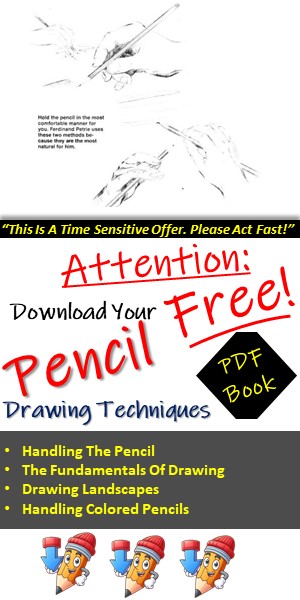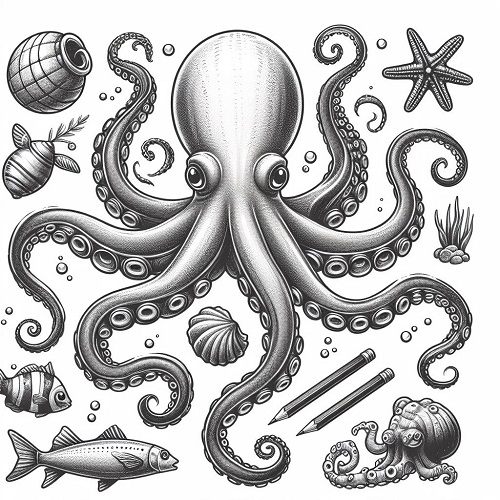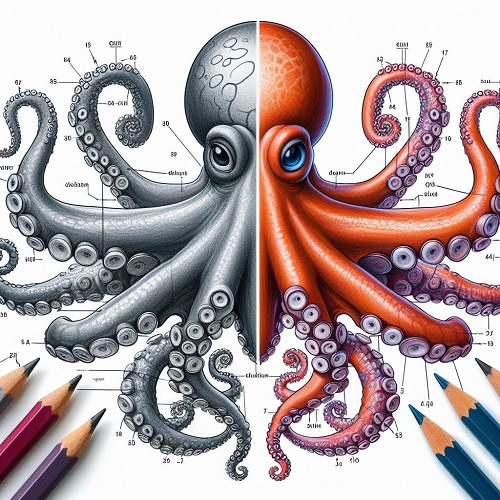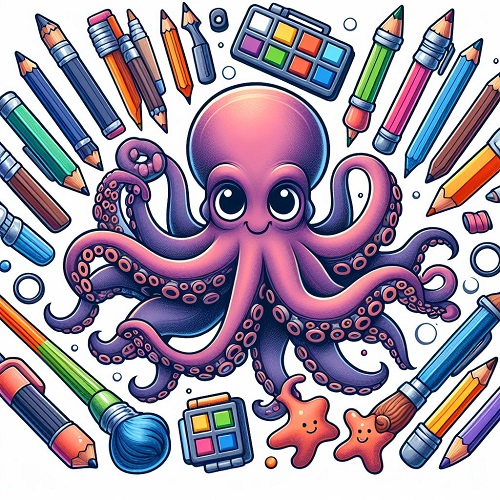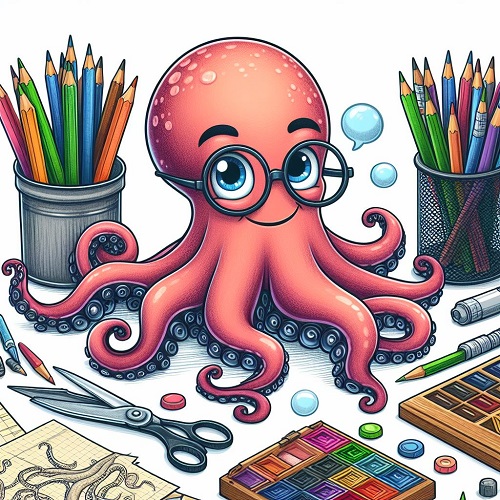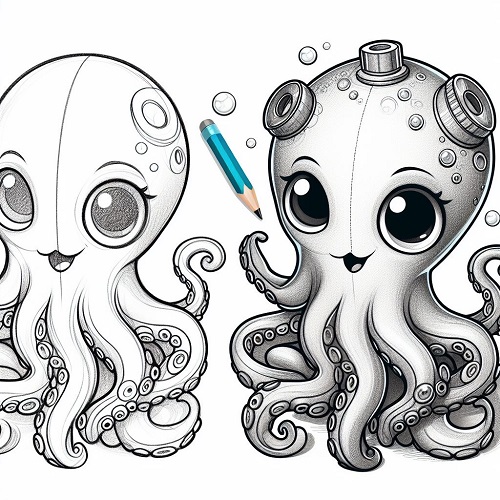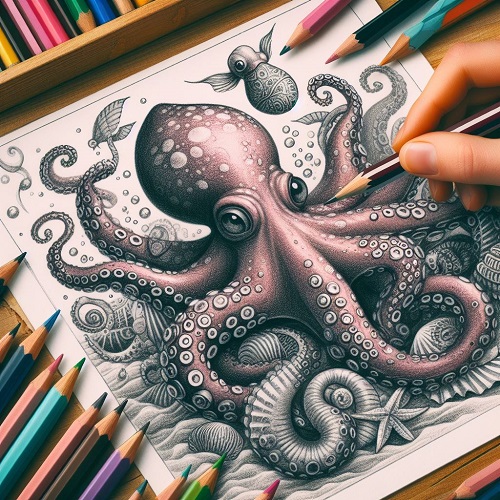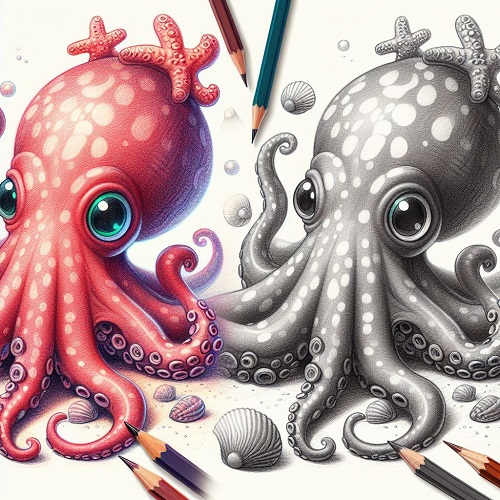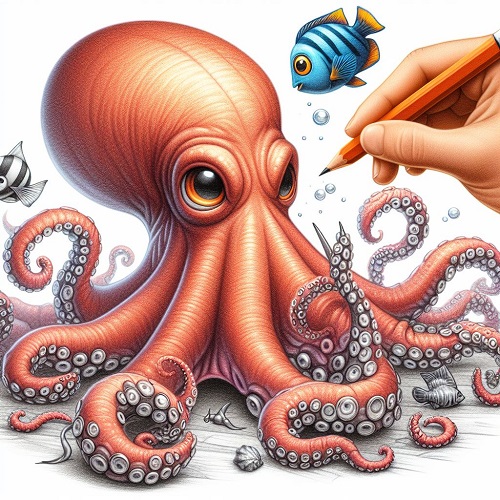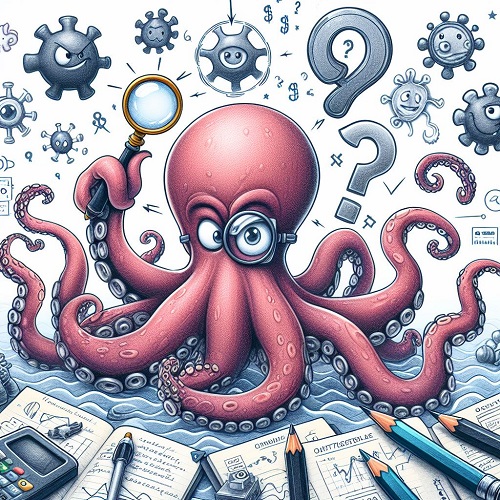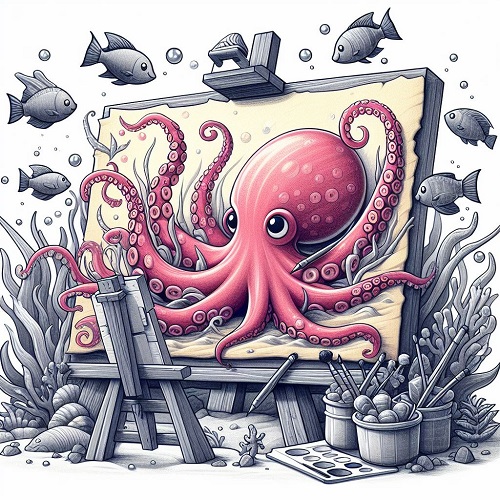Unleashing the Depths of Creativity: A Comprehensive Guide to Octopus Pencil Drawing
Welcome to the enchanting realm of octopus pencil drawing, where the elegance and complexity of these sea creatures become a canvas for your artistic expression. In this extensive guide, we’ll embark on a journey that goes beyond the surface, exploring the intricacies of octopus anatomy, unraveling the art of pencil drawing, and offering step-by-step guidance to help you create a masterpiece that captures the essence of these underwater wonders.
Understanding the Octopus Anatomy
In-Depth Exploration of Octopus Features
Octopuses, with their remarkable features, serve as an endless source of inspiration for artists. The elongated, flexible tentacles, adorned with rows of suction cups, create a mesmerizing pattern that demands attention. Each tentacle tells a story, reflecting the dexterity and intelligence of these creatures. The eyes, expressive and captivating, convey a depth of emotion that adds a unique challenge and charm to your drawing.
Studying Octopuses for Realistic Representation
To truly understand the nuances of octopus anatomy, immerse yourself in the world of these marine beings. Observe their movements, study the interplay of light on their skin, and capture the fluidity of their form. This section will guide you through the process of observation, offering tips on how to translate your observations into a realistic representation on paper.
FAQ: How can I capture the intricate details of octopus anatomy in my drawing?
Start by focusing on one tentacle at a time, studying the placement and curvature. Pay attention to the variations in suction cup size and texture. Experiment with different shading techniques to convey the translucency of their skin, allowing your drawing to mirror the captivating essence of these creatures.
Gathering Your Drawing Tools
Essential Pencil Drawing Supplies
Before diving into your artistic venture, equip yourself with the right tools. Explore the nuances of different pencils, from the hardness that influences line weight to the varied textures they can produce. Selecting the right paper is equally crucial, as it serves as the foundation for your masterpiece. Discover the role of erasers and sharpeners in achieving precision and clarity in your octopus pencil drawing.
Optional Tools for Finesse
Elevate your drawing skills by incorporating optional tools that add finesse to your artwork. Blending stumps, for instance, can soften edges and create smooth transitions, while specialized pencils designed for shading and texture can enhance the realism of your octopus representation. This section will guide you in selecting and using these tools effectively.
FAQ: Do I need to invest in specialty pencils for octopus pencil drawing, or can I achieve good results with standard pencils?
While standard pencils can produce excellent results, specialty pencils designed for shading and texture can elevate your drawing to a new level. Experiment with both to find the right balance for your desired effect.
Preparing Your Workspace
Creating the Ideal Drawing Environment
A conducive workspace sets the stage for your artistic journey. Adequate lighting is crucial for precision, so position your drawing area near a natural light source or invest in quality artificial lighting. Keep your tools organized to minimize distractions and maintain focus during extended drawing sessions. This section provides practical tips for creating an environment that enhances your creative process.
Comfort and Focus During Drawing Sessions
Drawing sessions can be immersive, requiring extended periods of concentration. Explore techniques for maintaining comfort and focus, including ergonomic considerations, regular breaks, and mindfulness practices. By cultivating a harmonious workspace, you’ll find yourself more attuned to the creative flow.
FAQ: How does the workspace environment impact the quality of my octopus pencil drawing?
The workspace environment plays a pivotal role in the outcome of your artwork. Proper lighting ensures accurate depiction of shadows and highlights, while an organized space minimizes distractions, allowing you to fully immerse yourself in the creative process.
Sketching and Initial Outline
Importance of a Preliminary Sketch
Embark on your drawing journey by laying the foundation with a preliminary sketch. This step is crucial for mapping out the proportions and overall composition of your octopus drawing. Learn techniques for achieving balance and symmetry, ensuring a solid base upon which to build the intricate details.
Step-by-Step Guide for Outlining the Octopus Form
Follow a detailed step-by-step guide to outline the unique form of an octopus. From the positioning of tentacles to capturing the fluidity of movement, this section provides insights into the specific elements that contribute to a lifelike representation. Tips on choosing the right pencil and stroke techniques will be included to guide your hand through this crucial phase of the artistic process.
FAQ: Should I use a reference image for the preliminary sketch, or can I draw from imagination?
Using a reference image is highly recommended, especially if you’re aiming for realism. A reference provides valuable insights into the proportions and details of an octopus, allowing you to capture its essence more accurately. As you gain confidence, you can gradually incorporate elements from your imagination.
Adding Depth and Texture
Mastering Techniques for Realistic Suction Cups
Suction cups are distinctive features of an octopus, and mastering the art of rendering them realistically is essential. This section will guide you through techniques such as cross-hatching and shading to create the illusion of depth and texture. Learn how to convey the three-dimensional quality of suction cups, making your octopus come alive on paper.
Emphasizing the Intricate Details of Octopus Skin
The skin of an octopus is a canvas of intricate details, from subtle patterns to varying textures. Dive into the world of fine details, exploring the use of different strokes and shading techniques to replicate the complexity of their skin. Discover how attention to detail can elevate your octopus pencil drawing to a new level of realism.
Incorporating Texture for Visual Appeal
Texture adds visual interest to your artwork, and in the case of an octopus, it brings out the tactile nature of their skin. This section will delve into techniques for incorporating texture into your drawing, from creating a velvety soft appearance to mimicking the roughness of certain areas. Experimentation is encouraged, as texture can be a powerful tool in conveying the essence of your subject.
FAQ: How can I avoid overworking my drawing when adding texture?
Achieving the right balance is key when adding texture to your octopus drawing. Take breaks to step back and assess your progress regularly. Avoid excessive detailing in one area before addressing the entire drawing, ensuring a harmonious distribution of texture across the entire artwork.
Mastering Shading and Light
Understanding Light Sources and Their Impact
Light plays a crucial role in pencil drawing, influencing the mood and realism of your artwork. Explore the fundamentals of light sources and their impact on an octopus drawing. Understand how shadows and highlights interact with the three-dimensional form, enhancing the depth and visual appeal of your creation.
Creating Realistic Shadows and Highlights
Shading is an art form in itself, and when applied skillfully, it breathes life into your drawing. This section will guide you through the process of creating realistic shadows and highlights, emphasizing the importance of observation and control over your pencil strokes. Learn how to use shading techniques to model the form of an octopus, making it appear more tangible and captivating.
Utilizing Shading Techniques for Depth and Dimension
Shading is not just about darkening certain areas; it’s about conveying depth and dimension. Explore advanced shading techniques such as stippling, hatching, and cross-contouring to add complexity to your octopus drawing. Understand how to create a sense of volume and form by strategically applying shading techniques, enhancing the overall visual impact of your artwork.
FAQ: How do I choose the right shading technique for my octopus pencil drawing?
The choice of shading technique depends on the effect you want to achieve. Experiment with various techniques on a separate sheet of paper to see how they interact with each other and with the unique features of an octopus. Over time, you’ll develop an intuitive sense of which techniques work best for different aspects of your drawing.
Bringing the Octopus to Life
Adding Personality to the Eyes
The eyes are often considered the focal point of any drawing, and for an octopus, they are windows into its soul. This section will guide you in capturing the expressiveness of octopus eyes, from the reflective quality of the pupils to the subtleties of their gaze. Discover how to infuse personality and emotion into your drawing by paying special attention to this crucial element.
Enhancing Realism Through Fine Details
Fine details are the hallmark of a skilled artist. Explore the art of adding intricate details to your octopus drawing, whether it’s the tiny bumps on the skin, the delicate webbing between tentacles, or the subtle variations in color. This section will delve into the importance of patience and precision, urging you to embrace the meticulous process of refining your artwork to achieve a heightened level of realism.
Tips for Capturing the Essence of an Octopus
Capturing the essence of an octopus goes beyond mere technical skill. Learn how to infuse your drawing with a sense of movement, grace, and mystery. This section provides practical tips on achieving a balance between accuracy and artistic interpretation, allowing your unique style to shine through while honoring the captivating nature of these oceanic beings.
FAQ: How can I avoid making my octopus drawing look too rigid or stiff?
To avoid stiffness in your drawing, observe the fluidity of octopus movement and translate it onto paper. Incorporate subtle curves and variations in line weight to convey a sense of motion. Regularly step back from your drawing to assess the overall flow, making adjustments as needed to maintain a dynamic and lifelike representation.
Troubleshooting Common Challenges
Addressing Proportion Issues
Proportion is a common challenge in art, and octopus pencil drawing is no exception. Learn how to identify and address proportion issues, whether it’s uneven tentacle lengths or a misaligned body structure. This section provides practical tips for using reference points, measuring techniques, and visual comparisons to ensure a well-proportioned and balanced octopus drawing.
Dealing with Smudging and Erasing Mishaps
Smudging and erasing are part of the artistic process, but they can pose challenges, especially in pencil drawings. Discover effective ways to prevent smudging, such as using a protective sheet or strategic hand placement. Learn how to approach erasing mishaps without compromising the integrity of your drawing, maintaining clarity and precision throughout the creative process.
Overcoming Difficulties in Replicating Intricate Details
Replicating intricate details, while rewarding, can also be demanding. This section offers guidance on breaking down complex details into manageable components, allowing you to tackle each aspect with focus and precision. Learn how to use magnification tools if necessary and develop strategies for maintaining patience and perseverance as you navigate the intricacies of your octopus drawing.
FAQ: What should I do if I accidentally smudge an important detail in my drawing?
If you accidentally smudge a crucial detail, don’t panic. Allow the smudge to dry completely before attempting to fix it. Use a clean, soft eraser or a specialized smudge eraser to gently lift the smudged graphite. If the smudge is extensive, consider reworking the affected area with deliberate strokes to blend it into the overall texture of your drawing.
Showcasing Your Masterpiece
Tips for Framing and Presenting Your Artwork
Your octopus pencil drawing deserves a fitting presentation. Explore tips on selecting the right frame, matting, and mounting options to complement your artwork. Consider the overall aesthetic and theme you want to convey, ensuring that the framing enhances the visual impact of your masterpiece.
Sharing Your Artwork Online and Seeking Feedback
In the digital age, sharing your artwork online opens up opportunities for connection and feedback. This section will guide you through the process of showcasing your octopus drawing on various platforms, from social media to dedicated art communities. Learn how to engage with fellow artists, seek constructive feedback, and celebrate the collective passion for octopus art.
Connecting with the Octopus Art Community
Joining the octopus art community can be a rewarding experience. Discover online forums, groups, and events dedicated to cephalopod-inspired art. This section provides insights into building connections, learning from fellow artists, and staying inspired by the diverse interpretations of octopus drawings within the community.
FAQ: Is it necessary to showcase my octopus drawing online, or can I keep it private?
The decision to showcase your artwork online is entirely personal. While sharing your creations online provides exposure, connecting with a wider audience, and receiving valuable feedback, it’s not mandatory. If you prefer to keep your octopus drawing private, consider sharing it with close friends, family, or local art communities where you can still receive appreciation and encouragement in a more intimate setting.
Conclusion
As we conclude this comprehensive guide to octopus pencil drawing, take a moment to appreciate the journey you’ve undertaken. Embrace the joy of translating the mesmerizing world of octopuses onto paper, infusing your unique artistic voice into every stroke. Whether you choose to keep your masterpiece private or share it with the world, remember that the beauty lies not just in the finished artwork but in the transformative process of creation. Happy drawing!
- Mastering the Art: A Comprehensive Guide to Pokemon Pencil Drawing
- Mastering the Art of Pencil Drawing on Canvas: Your Comprehensive Guide
- Unveiling Artistry: A Comprehensive Guide to Horse Pencil Drawings
- Mastering the Art of Pencil Drawing Cartoon Characters: A Comprehensive Guide
- Unleash Your Creativity: A Comprehensive Step-by-Step Guide to Colored Pencil Drawing
- Unleashing the Depths of Creativity: A Comprehensive Guide to Octopus Pencil Drawing
- Unlocking the Artistry: A Deep Dive into Black Pencil Drawing
- Mastering the Art of Tree Pencil Drawing: A Step-by-Step Guide for Aspiring Artists
- Dive into Creativity: The Magic of Underwater Pencil Drawing
- Unleashing Creativity: Mastering the Art of 2B Pencil Drawing
